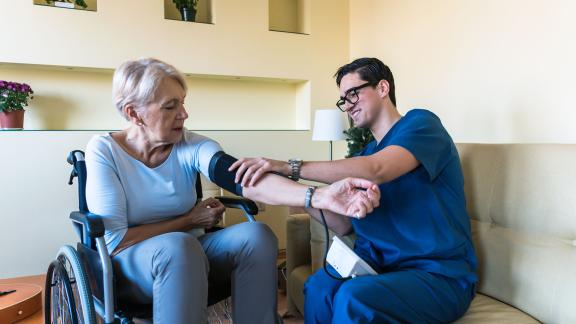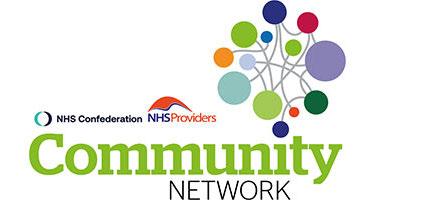Supporting admission avoidance in Hertfordshire

Hertfordshire Community NHS Trust and partners at East of England Ambulance Service NHS Trust (EEAST) have collaborated to deliver several interventions to support admission avoidance at every stage of the UEC pathway.
The case study is produced by the Community Network, which is hosted by the NHS Confederation and NHS Providers.
Key benefits and outcomes
- In the pilot week of the interventions, HCT clinicians assessed 103 patients who would have otherwise been conveyed to East and North Hertfordshire NHS Trust (ENHT).
- 19 per cent reduction in conveyance rate from EEAST to ENHT during the pilot week
- Reduced number of patients waiting outside of the hospital
- Ambulance sector colleagues freed up more quickly, enabling them to reduce waiting times for other 999 callers.
About the organisations
Hertfordshire Community NHS Trust (HCT) provides care to over 1.2 million people across Hertfordshire and the East of England. The trust employs 3,000 staff, including podiatrists, health visitors, nurses and speech and language therapists, and is one of the largest employers in Hertfordshire.
East of England Ambulance Service NHS Trust (EEAST) serves a population of 6.3 million people across Bedfordshire, Cambridgeshire, Essex, Hertfordshire, Norfolk and Sussex, and employs nearly 5,000 staff.
HCT and EEAST are both part of the Hertfordshire and West Essex ICS.
What the organisations faced
There have been challenges within urgent and emergency care (UEC) pathways for many years, both at a national level and for the Hertfordshire and West Essex ICS.
As the peak of the COVID-19 pandemic passed there was a step change in the level of pressure facing UEC pathways, leading to increasing waiting times for ambulances and time taken for patients to be handed over from ambulances.
In the face of these pressures, the HCT team reflected that more people could be treated safely in the community. They found that system partners did not always understand the care that could be delivered in the community, meaning that the value of community teams was not being utilised to support admission avoidance.
What the organisations did
In response to NHS England’s 100-day challenge, which was launched in November 2021, HCT and EEAST worked together to drive forward collaboration to support pressures on UEC pathways.
Urgent community response services were the starting point, and the organisations have now built out from here to better understand further opportunities for collaboration and supporting admission avoidance.
A multidisciplinary hub, which HCT has operated since 2020, has been instrumental to partnership working, and during the pilot paramedics worked at the hub to support a joined-up approach.
HCT and EEAST work collaboratively in several ways to intervene at key junctures in a person’s interaction with the UEC pathway. Firstly, for category 3, 4 and 5 calls, the HCT team, working in the hub with paramedic colleagues and triage patients, proactively intervene to dispatch a community team to see a person before an ambulance is deployed.
For category 1 and 2 ambulance calls, the ambulance crew can call the HCT team when they are on the scene, and discuss the potential to handover to a community team. This forms part of the ‘handover at home’ pilot, which is focused on people aged over 75.
Finally, where a person has already been conveyed, HCT and EEAST can examine who is waiting outside of hospital in an ambulance, and where a person could receive the follow-up care they require at home, potentially through a hospital-at-home service.
Looking forward, the team is considering ways to develop this further, including by working with voluntary sector partners and opening up the handover at home model outside of people aged over 75. The model is being presented at a UEC board as a proposal to be considered for wider rollout across the whole ICS.
Overcoming obstacles
The HCT and EEAST teams have worked collaboratively to overcome key obstacles around GDPR, data protection, and technical access to computer-aided dispatch outside of the ambulance sector. The teams at HCT and EEAST have also reached agreement about which organisation takes clinical responsibility at different stage of a pathway.
Technical solutions were an important part of overcoming these challenges. However, buy-in from senior leaders, a dedication to partnership working, and a willingness to accept and agree risk-sharing, enabled partners to progress towards finding those solutions.
Face-to-face working has also supported HCT and EEAST to overcome obstacles and making improvements for the benefits of patients and the local system. Physical co-location at the MDT hub provides an opportunity for members of the two organisations to jointly triage and discuss the management of patients.
Results and benefits
- Over the course of the pilot week, HCT clinicians assessed 103 patients who would have otherwise been conveyed to East and North Hertfordshire NHS Trust (ENHT), and there was a 19 per cent reduction in conveyance rate from EEAST to ENHT during the pilot week.
- Following HCT intervention and referral into appropriate services, the conveyance rate was reduced to 33 per cent (34 conveyed, 69 non-conveyed).
- The pilot helped to reduce the number of patients waiting outside of the hospital, including the 10 per cent of patients transferred to HCT when ambulances were waiting for handover.
- Ambulance sector colleagues were freed up more quickly, which enabled them to reduce waiting times for other 999 callers.
- When data is extrapolated to a full year, it indicates an opportunity to deliver 3,796 avoided conveyances in east and north Hertfordshire, including over 1,000 for elderly fallers.
- When population data is extrapolated, it suggests that there is an opportunity across Hertfordshire and West Essex for about 9,500 avoided conveyances across the ICS per year.
- No harm has been recorded and there have been no adverse incidents to date.
- For people who have fallen, a benefit of a community-based intervention is that the team will refer them into a community frailty service, which can help to prevent a future fall.
Takeaway tips
- Engage with senior leaders to secure their buy in.
- Maintain strong senior leadership and clinical reassurance to support frontline staff to work in new ways.
- Dedicate the time to developing partnership working.
- Work in an agile way to deal with new challenges.
- Communicate with system partners about the care that can be delivered in the community.
- Raise the profile of the work you’re doing among ICS colleagues.
Further information
For more information about this case study, contact the communications team at Hertfordshire Community NHS Trust: hct.communications@nhs.net.



